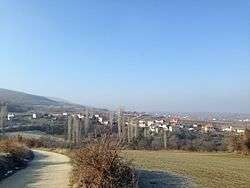Pagaruša, Studeničani
Pagaruša (Macedonian: Пагаруша) is a village in the municipality of Studeničani, North Macedonia.
Pagaruša | |
|---|---|
Village | |
| Пагаруша | |
 | |
 Pagaruša Location within North Macedonia | |
| Coordinates: 41°53′N 21°30′E | |
| Country | |
| Region | |
| Municipality | |
| Population (2002) | |
| • Total | 227 |
| Time zone | UTC+1 (CET) |
| • Summer (DST) | UTC+2 (CEST) |
| Car plates | SK |
| Website | . |
History
During the great migration movements in Macedonia at the end of the 17th and beginning of the 18th centuries, Macedonian Muslims left the Debar area for the central regions of Macedonia and established villages such as Pagaruša located in the Skopje area.[1]
Demographics
Pagaruša has traditionally been inhabited by a Macedonian Muslim (Torbeš) population.[1] The mother tongue of Pagaruša inhabitants and of daily communication is Macedonian.[2] The village has undergone some depopulation as villagers have migrated to Turkey or nearby Skopje and surrounding villages in North Macedonia.[2] Though most Macedonian Muslims are Sunni, in Pagaruša followers of Sufi Islam are present attached to various Sufi orders such as the Melami, Halveti and Bektashi.[3]
According to the 2002 census, the village had a total of 227 inhabitants.[4] Ethnic groups in the village include:[4]
See also
References
- Vidoeski, Božidar (1998). Dijalektite na makedonskiot jazik. Vol. 1. Makedonska akademija na naukite i umetnostite. ISBN 9789989649509.CS1 maint: ref=harv (link) p. 126. "Еден дел од торбешката група, кои на крајот на XVII век и во почетокот на XVIII-иот, во времето на големите миграциони движења во Македонија, ја напуштило старата територија (Дебарско) и се преселило во централните области на Македонија. Така се формирале шет торбешки села во Скопско (Пагаруша, Д. Количани, Држилово, Цветово, Елово, Умово) и две Велешко (Г. Врановци и Мелница)."
- Idrizi, Xhemaludin (2003). Mikrotoponimia e Karshikës së Shkupit [Microtoponyms of Skopje’s Karshiaka region. Skopje: Interdiskont. pp. 17, 45–46. ISBN 9989-815-37-2.CS1 maint: ref=harv (link)
- Telbizova-Sack, Jordanka (2005). "Eine Identität mit vielen Gesichtern? Die slawischen Muslime Makedoniens". In Keul, István (ed.). Religion, Ethnie, Nation und die Aushandlung von Identität(en): regionale Religionsgeschichte in Ostmittel- und Südosteuropa. Frank & Timme GmbH. p. 52. ISBN 9783865960092.CS1 maint: ref=harv (link). "Die Mehrheit der Torbeschen sin Sunniten. Anhänger der Derwisch-Orden der Halveti, der Melami und der Bektaschie lassen sich vereinzelt in Kičevo sowie in den Dörfen Pagaruša und Melnica finden.
- Macedonian Census (2002), Book 5 - Total population according to the Ethnic Affiliation, Mother Tongue and Religion, The State Statistical Office, Skopje, 2002, p. 184.
| Wikimedia Commons has media related to Pagaruša. |